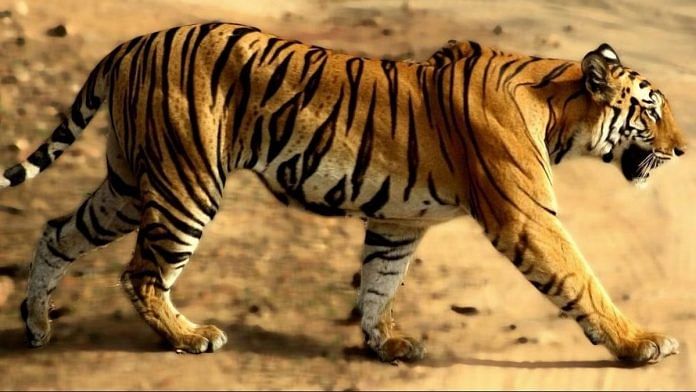On May 4, 1990, a juvenile tigress of about ten months, with injuries in her body, had wandered into the fringes of a village on the southeastern end of the park. The villagers had gathered in a violent mob that mercilessly stoned her to death. She was 212 centimeters long with a 75-centimeter tail and weighed only 80 kilograms. This juvenile tigress was slightly larger than a male leopard.
The reality was that, unusually, four wild tigers had been found dead in different corners of Nagarahole in the previous two months. There was a fifth one too, Mudka, whom I found only because of my radio-tracking.
These facts were enough to get the rumor mills around the jungles grinding.
When Tigers Die, Rumors Fly
Speculation and gossip about the tiger deaths was soon rife in the jungle grapevine, which interconnected the many arrack vends, toddy shops, and bars in the villages on the fringes of Nagarahole Park. Tribesmen, poachers, timber thieves, and illicit collectors of forest produce gathered at these places to drink and trade stories. On the sly, some off-duty forest guards joined them, too. Deals were struck, bribes changed hands, and stories were retold. A rumor casually planted by a forest guard at these conclaves carried the additional stamp of official authority. By the end of April 1990, one specific story had gained currency: the deaths of these five tigers were linked to my research project, specifically, to the tranquilizations that preceded the radio-collaring of tigers. This rumor flew in the face of facts, because four of the five dead tigers had never been radio-collared. Even Mudka, the only collared tiger to die, had fully recovered from the tranquilization six weeks earlier. He had been radio-tracked by me and seen by others several times before he had died as predicted.
I suspected this rumor was floated by the aggrieved ranger GR. However, with corruption and secrecy being rampant, a word-of-mouth rumor can take wings and soar like black eagles do over the Malenad landscape. And this one did. Soon the rumor became breaking news in cold print. KG’s tabloid Star Dirt “scooped” the ridiculous rumor as a sensational fact: tigers were being secretly caught, tranquilized with a dangerous drug, and fitted with radio collars. These poor animals were dying, one after another. The perpetrator was a well-connected researcher with unlimited amounts of money. Corrupt forest officials colluded with the researcher to run this international criminal enterprise.
The scoop was soon picked up by other local tabloids and, eventually, state-level newspapers in Bangalore. Because of its sensational originality and news value, even the national press picked up the news. A major national paper ran the story under the headline “Blood on the Collar.” As far as media coverage was concerned, I was toast. “Karanth’s tiger scandal” was the flavor of the month during May 1990.
The minister for forestry in Karnataka State, BB, was a powerful politician. He had risen from the ranks of the oppressed Dalit class: India’s former “untouchables.” He had fought long and hard for their upliftment, boldly challenging the social hegemony of the upper castes. His bete noirs were the Brahmins, who traditionally claimed superiority over all other castes.
It was true my father was born a Brahmin. However, he had turned a rationalist in his late teens, thrown away his sacred thread, and some years later married my mother from a warrior caste, setting off a social storm in the 1930s. That made a me a blue-blooded half-caste, I thought. A colleague in Wildlife Conservation Society (WCS) had once introduced me by saying, “You have all heard of Boston Brahmins, but here is the real McCoy.” Now, my Brahminical surname Karanth became the bull’s-eye for the minister’s target practice.
Many local people around Nagarahole, not just the forest criminals, resented the strict enforcement of conservation laws that barred their earlier hunting, forest extractions, and encroachments. They bore a particular grudge against Chinnappa for being a tough enforcer, unlike GR, who had given them a free rein. Because I had played a role in Chinnappa’s return, I was also on their blacklist.
All these social forces were being forged into a formidable vendetta by the wild rumor mongering in the media. Soon these hostile forces converged under the leadership of the legislator CU from Hunsur. She had felt humiliated when I did not accede to her request to witness the capture of Mudka. She now canvassed hard with Minister BB to get rid of me from Nagarahole. BB bluntly asked Appayya and Alva, two senior officials who had helped with my research permit, “Of what use is this tiger research?” Apparently, their defense of science did not satisfy him. His next question was why a free-spirited wild animal like the tiger should be burdened with a heavy collar around its neck. The officials explained the collar weighed less than half a percent of the tiger’s weight and did not hinder its activities. They pointed out even smaller animals like birds and bats were being routinely radio-tagged in advanced countries.
BB was furious at what he saw as defiance by these officials. He shouted at them, saying, “If the radio collar is not a burden at all, I will order all of you to wear them to work every day. At least I will get to know what you guys are up to behind my back.” A crestfallen Alva, a good friend of many years, called to tell me he could not protect me from the minister’s fury.
Soon I got an official letter ending my five-year research permit, lock, stock, and barrel. I was stunned. Although I tried to plead my cause with a few journalists, I was coming too late into the news cycle. The sensational “Karanth tiger scandal” was steadily driving up their readership.
However, the most senior forester in the state, Paramesh, was a feisty, well-informed man. He called his boss, Minister BB, to bluntly tell him what he was doing was wrong. In defiance of official protocols, Paramesh even went on television to publicly disagree with the minister. Appayya, Lakshmana, and Alva, who understood what I was going through, were sympathetic but helpless. I felt truly grateful for the moral support from these senior officials. Somewhat belatedly, I started meeting influential politicians to explain the facts. The Federal Environment Minister Maneka Gandhi, Indira Gandhi’s second daughter-in-law, was (and is) an animal lover. She tried to convince BB to let me continue my work. While BB lauded her late mother-in-law profusely, he dodged her specific request. A former chief minister, Gundu Rao, also tried his hand but failed. He told me plainly, “Karanth, no one can change this stubborn man’s mind. Your only option is to challenge this termination in the High Court of Karnataka.”
My next stop was the law office of Udaya Holla, a rising star among Bangalore’s lawyers. A few years younger than I was, Holla and I shared the same roots in coastal Karnataka. He admired my father greatly. However, I was aware his fees were high and he was busy fighting cases for rich corporate clients.
Holla invited me in; he was on the phone talking to someone named “Craig Bolt” in Airbus Industries in Paris. One of their planes had crashed on landing at Bangalore few days earlier. Holla was their attorney. I had a sinking feeling he would have no time for me.
After getting off the phone, Holla heard me patiently. I could see he was getting interested. My case was entirely novel and very different from his usual ones. I was fighting for my academic freedom guaranteed by the Indian constitution; it was my right as a citizen to study tigers. After a couple of minutes Holla stopped me, saying, “Karanth, I will fight your case.” Before I could bring up the matter of his legal fees, he added, “and I will do so pro bono.” I choked with emotion. Thanking Holla, I left his office.
I convened a meeting of the small “crisis management” group that spontaneously emerged as the “scandal” unfolded. It consisted of a handful of passionate friends who had participated in my research project as volunteers-Krishna, Prasad, and Praveen, and a wealthy coffee planter named Nachaiya, who was a friend and admirer of Chinnappa.
A week later, Holla stood up and pleaded our plaint in the halls of justice, the impressive red-brick building of the High Court of Karnataka in Bangalore. The judge hearing the case was a stickler for rules. After hearing Holla briefly, the judge termed the order terminating my project arbitrary because it gave no reason and violated “natural justice.” The judge issued a stay order-legalese for holding the termination in abeyance. I was free to resume my research until the case was decided. Being rather naive, I was elated!
I was back in Nagarahole on June 29, 1990, trying to track my three tigers and three leopards. On the next day, while clearing a firebreak around Mavinahalla, forest guards found the scattered remains of some animals. I went there to investigate, hoping to find a carcass of some prey animal killed by a predator. However, on seeing the scattered scraps of meat and skin, I was stunned. They were remains of two tiger cubs. The killer had almost entirely consumed them. A few scattered bones and two dog-sized skulls was all the evidence he left behind.
I had seen these two cubs with their mother, the Mavinahalla tigress, a couple of times before. She usually brought them to the pond late in the evenings to drink and play, after they had fed on some prey animal the tigress had caught nearby. For the first two months, the tigress had nursed these cubs with her milk, as well as meat she regurgitated. When they were three months old, she started taking them directly to feed off her kills. When the killer cut their lives short the previous night, they were about six months old.
I did some quick calculations. Given the typical 110-day gestation, these cubs were produced by their mother mating sometime in October 1989. The male that sired them was most likely Mudka, who at that time was lording over this area.
Based on my radio-tracking data, I could also guess who the killer was. The previous evening, I had located Das in the area. He had probably detected the tigress and her cubs on a kill she made that night, and his infanticidal instinct had kicked in. The mother tigress stood no chance of protecting her cubs against the huge, 220-kilogram male tiger in a murderous mood.
This event showed Das was claiming at least this part of Mudka’s former range. As a transient male, Das had wandered over a seventy-seven square kilometer area. It looked as though he had finally succeeded in carving out a territory for himself. Although I felt sad for the two cubs, I knew their mother would soon come into estrus, mate again, and have new cubs.
The dynamic of tiger land tenures in Nagarahole was becoming more interesting by the day. Mudka’s fatal injury and his subsequent death had triggered a period of social turbulence. I wondered if the next litter of cubs of the Mavinahalla tigress would grow up to be adults. It depended on their father being able to hold on to this territory for an additional two or three years. If Das was lucky, his infanticidal behavior would pay off.
 This excerpt from K Ullas Karanth’s ‘Among Tigers: Fighting to Bring Back Asia’s Big Cats’ has been published with permission from Chicago Review Press.
This excerpt from K Ullas Karanth’s ‘Among Tigers: Fighting to Bring Back Asia’s Big Cats’ has been published with permission from Chicago Review Press.



